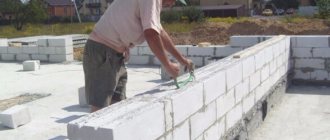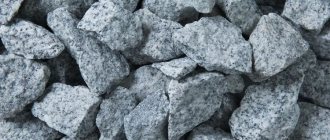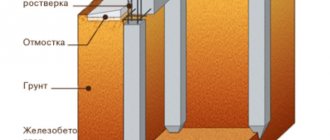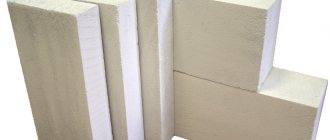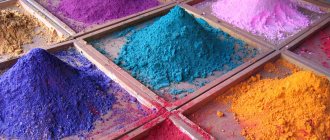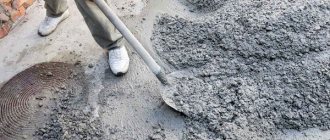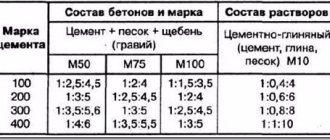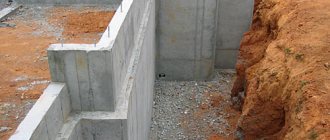Beton-House.com
Website about concrete: construction, characteristics, design. We combine the experience of professionals and private craftsmen in one place
Cellular concrete
Cellular concrete is the most popular material. Its distribution is associated with a large number of factors, including: physical and mechanical properties of the material, a wide variety of products made from it, availability of production and reasonable price.
The material is characterized by a fairly broad classification, which is determined mainly by the composition of the raw materials and the manufacturing method. So let's figure out what types of cellular concrete exist, how they differ from each other, and under the influence of what factors the properties and quality of products made from it can change.
- List of materials
- Manufacturing Features
What is the material
Cellular concrete belongs to the class of lightweight concrete and is distinguished mainly by the presence in its structure of pores that are filled with gas or air. There are a large number of varieties of this material, which we will now consider.
Pore structure of cellular concrete products
Classification
Gradation occurs in accordance with the following characteristics and parameters, according to GOST 25485 89 cellular concrete:
According to the type of binder component, the following types are distinguished:
- Cement containing cement in an amount of at least 50%.
- Calcareous. They consist of boiling lime in an amount of up to 50% of the total mass. May also contain gypsum, cement or slag additives in amounts up to 15%.
- Mixed. They contain 15-50% cement, lime and slag.
- Ash , consisting of more than 50% ash.
- Slag containing, respectively, slag in an amount of at least 50%.
Depending on the hardening method, cellular concrete is:
- Autoclaved
- Non-autoclave.
In the first case, the material achieves hardening by exposing it to high temperature and pressure during processing in specialized equipment - an autoclave. This type of hardening is also called synthetic hardening.
In the second case, this process occurs naturally, under normal conditions, or by electrical heating. The method is called hydration hardening.
Cellular concrete can be characterized by different densities and, as a result, differ in scope.
Autoclaved and non-autoclaved cellular concrete block
Depending on the above factors, there are:
- Thermal insulating cellular concrete;
- Thermal insulation and structural;
- Structural.
Thermal insulation - used exclusively as insulation. It has a low density, less than 500, but at the same time, an excellent thermal conductivity coefficient. It is not used in the construction of walls, since its load-bearing capacity excludes the ability to withstand any loads except its own weight, which is also relatively small.
The second version of cellular concrete is much more durable, the numerical value varies from 500 to 900. It is used in the construction of walls and partitions. At the same time, its ability to retain heat, of course, decreases in accordance with the increase in density.
Structural cellular concrete is the most durable. Its density reaches 1000-1200 kg/m3. However, as it becomes clear, the thermal conductivity coefficient is also high. It is used in the construction of buildings up to 12 meters high as the construction of load-bearing structural elements.
House built using cellular concrete blocks
Also, depending on the porousization method, the following types are distinguished among cellular concrete:
- Foam concrete and foam silicates;
- Aerated cellular concrete and aerated silicate;
- Aerated concrete and gas silicates.
In addition to the above methods, other modified methods are also used in the production of cellular concrete.
These include:
- Combination of gas generation and aeration method. As a result, foamed aerated concrete is obtained;
- Swelling of a mass in a vacuum due to gas formation;
- Bubbling the mass with compressed air followed by a decrease in pressure.
In accordance with the type of silica component, cellular concrete is divided into:
- Natural sand;
- On the ashes;
- On other secondary siliceous industrial products.
What is cellular concrete, classification
Advantages and disadvantages
Like any material, cellular concrete is not without its pros and cons.
Let's look at the positive aspects first:
- One of the most significant qualities is the thermal conductivity indicator. The material has a fairly high ability to maintain temperature, which significantly increases its value. This fact is easily explained: it’s all about the structure of the material, the pores of which contain air, which is a heat insulator. This characteristic is combined with sufficient strength.
As a result, the use of cellular concrete products in construction in the form of blocks will significantly reduce the cost of insulation, and in the future, heating costs. Soundproofing characteristics are also at a high level.
- The material is safe for the environment and humans. It does not emit harmful substances into the atmosphere.
- Products made from cellular concrete are easy to handle, which significantly increases the speed of construction and makes it possible to build structures with your own hands. In addition, the material is relatively light, which, in turn, reduces the load on the foundation when constructing walls using such blocks.
- High seismic resistance of structures built from this material.
- The combination of strength, density and weight leaves many building materials behind.
- The ability to vapor permeate allows buildings built using cellular concrete to “breathe”. Thus, a favorable microclimate is established in the room.
- Since the composition of cellular concrete is characterized by the presence of mineral components, the material does not rot or undergo other biological damage.
- The durability of cellular concrete is high. According to the manufacturers, a house built from this material will last at least 50-60 years.
Despite the large number of advantages, cellular concrete also has disadvantages. Its use causes some difficulties and the material cannot be called universal.
Let us once again pay attention to the fact that cellular concrete is a porous material. This fact is both a plus and a minus.
The thing is that the products have high water absorption capacity. Accumulated moisture can crystallize during periods of predominance of negative temperatures, and cause irreparable damage to the structure of the cellular concrete product. In this regard, such buildings require technically correct finishing both outside and inside the building.
Products made from cellular concrete are fragile. Most often this occurs during transportation and during work, when mechanical stress is most likely.
However, these shortcomings can be completely mitigated. In the first case, through properly executed masonry, finishing and correctly selected materials, and in the second, through careful handling.
Note! Cellular concrete requires special treatment and care when using. Defects in cellular concrete that appear in finished structures are, for the most part, of the same type and are directly related to improper use, masonry, lack of reinforcement or finishing.
Defect caused by shrinkage of the house
Cracks in aerated concrete
Gas formation
When using the gas generation method, special gas-forming agents (most often aluminum powder) are introduced into the concrete mixture. During the solidification process, they form gas bubbles, which, when trying to escape to the surface, form cells with numerous channels. The use of this method makes it possible to create various types of gas silicates and aerated concretes with the following properties:
- hygroscopicity;
- ability to withstand increased loads;
- strength;
- resistance to flame and high temperatures.
Aerated concrete blocks do not crack and do not shrink significantly. The degree of their thermal insulation is slightly lower than with foaming, but the strength is much higher, so thinner walls are obtained from aerated concrete with equivalent heat retention parameters.
Types of products made from cellular concrete
Products made from cellular concrete are presented in a wide range. They are actively used in the construction industry not only in Russia, but also in countries near and far abroad.
The market for cellular aerated concrete and foam concrete is growing every year, presenting consumers with an ever-increasing range of products. Let's consider what a developer can choose for himself among products made from this material?
List of materials
The following products are made from cellular concrete:
- Floor slabs, covering slabs;
- Large-sized blocks, reinforced and non-reinforced;
- Small wall blocks;
- Small thermal insulation products;
- Sound-absorbing products;
- Interior partitions;
- Wall panels;
- Tray and block lintels;
- Thermal insulation backfill.
Monolithic cellular concrete, which has the property of hardening under natural conditions on a construction site, is used in the manufacture of:
- Bases for underfloor heating;
- Multi-layer and single-layer enclosing structures of buildings;
- Thermal insulation layers of combined roofs.
Scheme: use of monolithic foam concrete
Hot cement concrete
I would like to highlight heat-resistant cellular concrete separately. During the operation and construction of thermal units, their use is necessary. This significantly saves materials and fuel.
And also: helps to create monolithic structures with increased thermal insulation ability, protect the structure (and/or unit) from high temperatures, create acceptable conditions for workers working in a hot shop, and much more.
Blocks made of cellular concrete: comparative characteristics and scope of application
The most popular products made from cellular concrete used in the construction of buildings are blocks. Their main types are: foam concrete and aerated concrete. The main difference between them is the manufacturing process itself and the method of creating pores.
- Cellular foam concrete is made using a special foaming agent. A solution consisting of cement, sand and water is moved into the mixer, where a foaming agent is added. As a result, the latter gives porosity to the products.
- Cellular aerated concrete is produced without the use of the above foaming component. Porosity is achieved through a chemical reaction of lime and aluminum powder, which is used as a blowing agent.
- Both types of blocks are quite actively used in the construction of buildings; the GOST for cellular concrete is also the same for both types. However, the palm still belongs to aerated concrete.
- Using the table, let's look at the main indicators of materials and figure out why foam concrete is losing to its competitor.
Table 1. Comparison of foam and aerated concrete:
| Indicator name | Explanations |
| Installation speed | The construction of a building from both materials will occur quite quickly. Both aerated concrete and foam concrete blocks are relatively large in size, while their weight is light. The products are easy to process; they can be sawed, polished, or given a special shape. |
| Appearance, accuracy of product geometry | In this indicator, aerated concrete wins. It looks more attractive and has precise geometry. But this can only be said about a factory-made unit, that is, an autoclave one. |
| Thermal conductivity | The difference in the thermal conductivity coefficient of these types of cellular concrete is very insignificant, however, less durable foam concrete still moves ahead. |
| Scope of application | Both materials have a wide range of applications. It depends, first of all, on the density of the block. They are used mainly: for insulating buildings, for the construction of walls and partitions, and less commonly, cellular concrete is used to fill the frame of a reinforced concrete structure. Aerated concrete is somewhat more common. |
| Price category | The price for foam concrete is lower. The difference is approximately 15%. |
| Environmental friendliness | The environmental safety parameter is equally good for both materials. They do not emit any toxic substances. |
| Assortment, choice of manufacturers | We can say that both materials are good in this regard. The building materials market is rich in producers of both foam and aerated concrete. The range of sizes is also wide. Moreover, some factories offer custom-made products. |
| Strength | If we compare the physical and mechanical characteristics of these materials, it turns out that with the same density, foam concrete is less strong. It is also worth noting that the density of the latter depends directly on the foaming agent, which must meet all quality indicators. Some manufacturers prefer to save on it. Also, the strength of foam concrete products is not completely uniformly distributed over the entire surface, which cannot be said about aerated concrete. |
| Fire resistance | About the same level. Both foam and aerated concrete are fire resistant and can withstand high temperatures for several hours |
As you can see, aerated concrete is the leader, but this does not mean that foam concrete is so bad. The advantage in price and thermal conductivity may well provide worthy competition.
It is also worth noting that foam concrete is more susceptible to shrinkage, although this indicator does not deviate from the technical documentation.
Note! Foam and aerated concrete also differ in their pore structure. In the first case they are closed, in the second they are open.
Foam concrete and aerated concrete comparison
Calculation of area of use
Today, cellular material is gaining wild popularity, so different brands of products are increasingly used in construction. It is important to make the correct calculation and decide on the brand. Most often used in such cases:
- for installation of load-bearing walls;
- for installing different types of screeds, both floors and ceilings;
- certain brands are used for installing floor coverings;
- for installation of load-bearing supports;
- in industrial construction.
Return to contents
Physico-mechanical, technical and other properties of products
Now, using the table, let’s look at the physical and mechanical indicators of the properties of cellular concrete, dictated by GOST 25485 89 cellular concrete technical conditions.
Table 2. Physical and mechanical properties of cellular concrete:
| Type of concrete, according to classification depending on density | Brand by density | Non-autoclaved concrete | Autoclaved concrete | ||
| Frost resistance, cycles | Compressive strength, class | Frost resistance, cycles | Compressive strength, class | ||
| Thermal insulating cellular concrete | D300-D500 | Not installed for thermal insulating cellular concrete | B0.5-B1 | Not installed | B0.5-B1.5 |
| Structural and thermal insulation | D500-D900 | 15-75 | B1-B3.5 | 15-100 | B1-B7.5 |
| Structural | D1000-D1200 | 15-50 | B5-B12.5 | 15-50 | B7.5-B15 |
As can be seen from the table, autoclaved cellular concrete is superior to non-autoclaved concrete in its physical and mechanical properties. This is due to the special production technology.
Experts recommend giving preference to synthetic hardening cellular concrete. They are more durable, reliable, and a building constructed from such material will have the highest performance characteristics.
Now it’s worth taking a look at the physical and technical indicators for cellular concrete - GOST 25485-89 dictates that products must have the following numerical values.
Table 3. Physical and technical parameters of products made of cellular concrete:
| Type of cellular concrete | Density grade | Thermal conductivity of concrete | Vapor permeability | Concrete humidity in % sorption, at air humidity from 75-97% |
| Thermal insulation | D300-D500 | 0,08-0,1 | 0,18-0,26 | 8-18 |
| Structural and thermal insulation | D500-D900 | 0,1-0,24 | 0,11-0,20 | 8-22 |
| Structural | D1000-D1200 | 0,23-0,38 | 0,8-0,11 | 10-22 |
- In accordance with these indicators, it becomes obvious that with increasing density, the thermal conductivity of cellular concrete, as well as its vapor permeability and sorption humidity also change.
- Separately, it is worth noting the shrinkage indicators of cellular concrete. They also directly depend on the density and type of cellular concrete.
- Thus, for autoclaved aerated concrete with a density of 600-1200, made from sand, the numerical value of shrinkage should not exceed 0.5 mm/m2 of area.
- For products whose silica component differs from the above, the maximum value is 0.7 mm/m2.
- Non-autoclaved aerated concrete, with a density of 600-1200, is allowed more - up to 3 mm/m2.
Note! Shrinkage of autoclaved cellular concrete with a density of up to 400 and non-autoclave concrete - up to 500, is not standardized by GOST.
Shrinkage, first of all, indicates the crack resistance of cellular concrete. The higher the indicator, the greater the likelihood of cracks appearing on the surface, which undoubtedly directly affects the durability and performance characteristics of the material.
Another important indicator established by the technical documentation is the release humidity.
Depending on the silica component, its value is:
- 25% for sand-based products;
- 35% for products based on ash and other secondary industrial products.
All of the above properties are subject to control in accordance with GOST, which also describes the basic acceptance rules.
Foaming
The foaming process occurs through the use of foaming additives based on protein hydrolysates, tree resin, and synthetic foam formers. During hardening, the finished solution begins to increase in size, and many closed pores appear in its structure, which are not connected by tubules. This method produces foam silicates and foam concretes having the following characteristics:
- high thermal insulation properties;
- small weight;
- ease of processing;
- environmental cleanliness.
Foam concrete is not as strong as aerated concrete, so it is not used for the construction of multi-story buildings. In addition, porous concrete of this type shrinks significantly and requires settling after production for at least 28 days.
According to the method used, the resulting concretes can have different characteristics.
| Characteristic | Foam concrete | Aerated concrete |
| Strength, MPa | 1,3 | 2,5 |
| Frost resistance | F25 | F35 |
| Thermal conductivity, W/mK | 0,12 | 0,11 |
| Moisture absorption,% | up to 16 | up to 20 |
| Vapor permeability coefficient | 0,14 | 0,2 |
Production technology and material testing methods
The production of cellular concrete is a rather labor-intensive process. And for each type there is its own special technology, which directly affects the quality indicators and characteristics of future products.
Manufacturing Features
As already mentioned, the manufacturing technology of various products is different, but the general principle is similar. For clarity, we will consider several options step by step. Let's start with the autoclave method.
The process occurs in the following order:
- The ingredients are fed from dispensers into the concrete mixer: first, sand, then the missing water, the binder, additives in the form of gypsum and surfactants, and, lastly, the gas-forming agent. Aluminum powder is most often used.
- To ensure the best reaction of the blowing agent and calcium hydroxide, the mixture of water and sludge is heated to 35%.
- All components are thoroughly mixed.
- Next, the mixture must be molded. There are 2 methods: injection molding and vibrocompression. In the first case, the process of gas formation occurs in a stationary form, using surfactants, changing temperature and water content. In the second - on a vibration platform.
- After the gas release process is completed, excess mixture is removed, and the semi-finished product is cut to the desired size.
- The next step will be processing the blocks in an autoclave.
The non-autoclave method is slightly different.
The production technology of non-autoclaved aerated concrete and foam concrete is extremely similar:
- First, prepare the solution by mixing all the components. Again, in the production of aerated concrete, mainly aluminum powder is added, and in the production of foam concrete - a foaming agent
- Next, the solution is sent to the molds. Setting occurs approximately after several days, after which the product is removed.
- Technical maturity of the block is subsequently expected to take about 28 days. At the same time, foam concrete products need constant moistening every 6-8 hours in the first 7 days, and later every 10-12.
- If equipment is available, the blocks are steamed in specialized chambers at a temperature of 70-80 degrees and a pressure of up to 0.7 MPa. This significantly speeds up the hardening process.
The production of monolithic aerated concrete is carried out using similar technology. After preparing the mixture, it is poured into formwork or other structures directly at the construction site.
The main disadvantage is the lack of control over the solution when used independently, and possible deviations from technical indicators. The video in this article will tell you more about the methods for producing various types of cellular concrete.
Testing
In accordance with GOST, there is a set of testing methods for products made of cellular concrete, with the help of which the quality of the output material is controlled and its compliance with established indicators. Let's take a closer look.
Table 4. Test methods for cellular concrete:
| Direction of the method | Essence |
| Determination of drying shrinkage | It consists of checking the change in the length of the tested samples when their humidity changes within the range of 5-35% of the total mass of the product. |
| Frost resistance | The essence of the method is to alternately influence samples by freezing and thawing them. The result of the test is an indicator indicating how many such cycles the product can withstand, while the compressive strength should not decrease by more than 15%, and the weight of the product - by more than 5%. The method applies to cellular concrete with a density of over 500, that is, structural and structural-thermal insulating concrete. |
| Compressive strength | The minimum force at which destruction of the control sample occurs is measured. |
| Thermal conductivity | The method consists of creating a heat flow that passes through the sample perpendicular to the largest faces. At the same time, the density of such a flow, the temperature of the edges of the product and the thickness are measured. |
| Holiday humidity | In accordance with GOST 12730.2-78, the method consists of testing the moisture content of concrete of crushed samples obtained after testing the strength or removed from ready-made buildings. GOST 21718-84 describes the dielectric method, which is based on the dependence of the sample’s vapor permeability (dielectric) on the amount of moisture it contains, subject to a positive temperature. |
| Sorptive humidity | The method is based on measuring the moisture content of a sample, subject to its preliminary drying to a certain constant mass and bringing it to an equilibrium state. This is done in an environment with air humidity of 40-97%, which is created artificially. |
| Average density | Dictated by GOST 12730.1-78 and GOST 17623-87. The latter describes a radioisotope method, which is based on the dependence of the density of concrete and the characteristics of gamma radiation. |
| Elastic modulus | The method consists of observing changes in the sample when exposed to it by compression and stretching. In this case, a graph is drawn up in the form of a diagram demonstrating the dependence of deformation on load. |
| Vapor permeability | The method consists of determining the vapor permeability resistance of products. |
| Prismatic strength | The method consists of gradually influencing the samples by applying a load until the state of destruction. During the process, product deformation is measured. |
These tests are carried out at certain intervals, also established by GOST. Many of the indicators are contained in the passport of cellular concrete.
Cellular concrete testing
Fillers
Cellular concrete is considered as a material in which air bubbles play the role of fine or coarse aggregate. In some cases, coarse aggregate is introduced into the material, which can be in the form of perlite, slag pumice, expanded clay, vermiculite or other expanded materials. Such components are also called cellular lungs.
Water absorption
One of the main properties that characterizes concrete is water absorption. This parameter depends on the type of binder component. Thus, concretes made from lime, gypsum, caustic magnesite or acoustic dolomite have higher absorption compared to concretes made from Portland cement. Significant water absorption indicates that foam and gas silicate can be used in rooms where the relative humidity is within fifty percent. Products made from gypsum foam can only be used in structures that are reliably protected from water.

